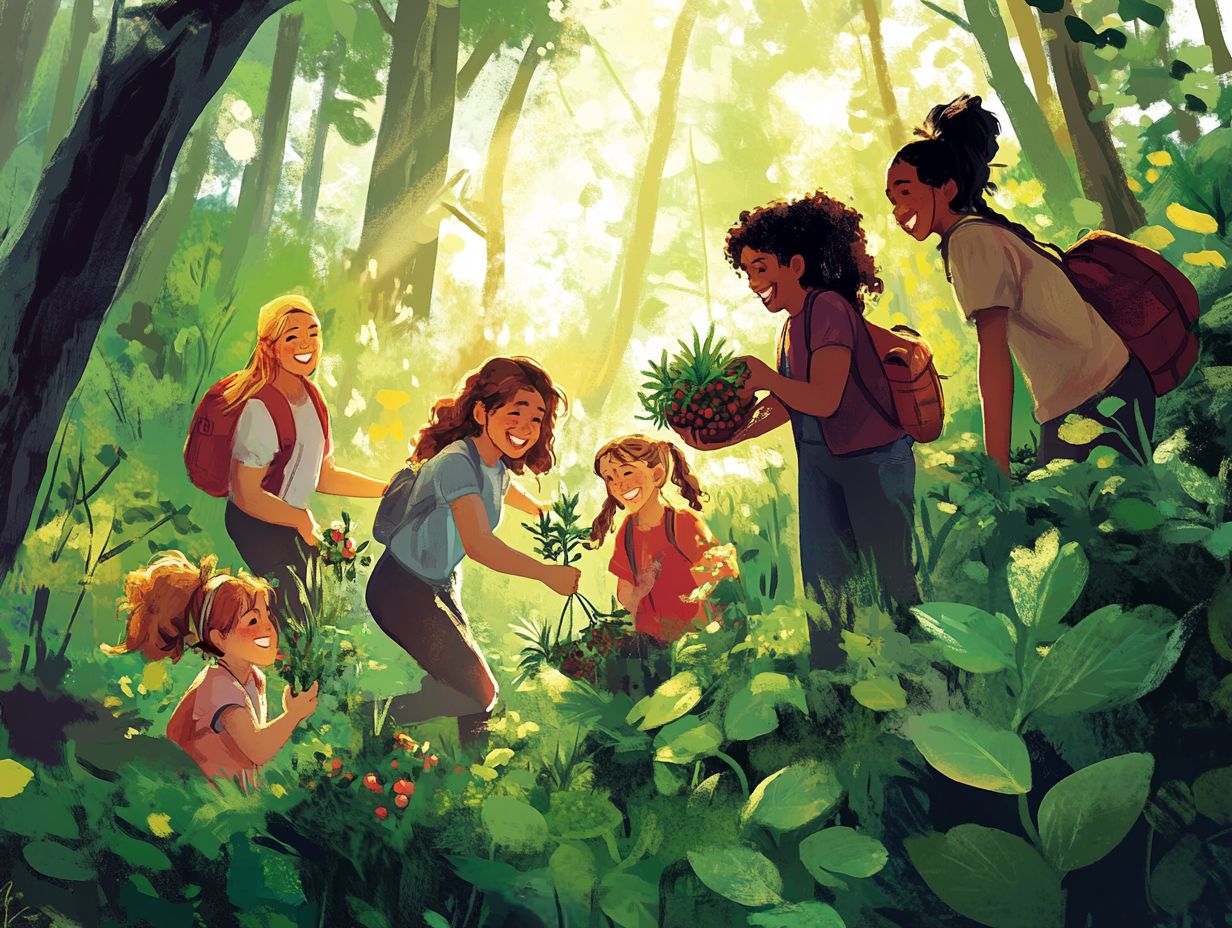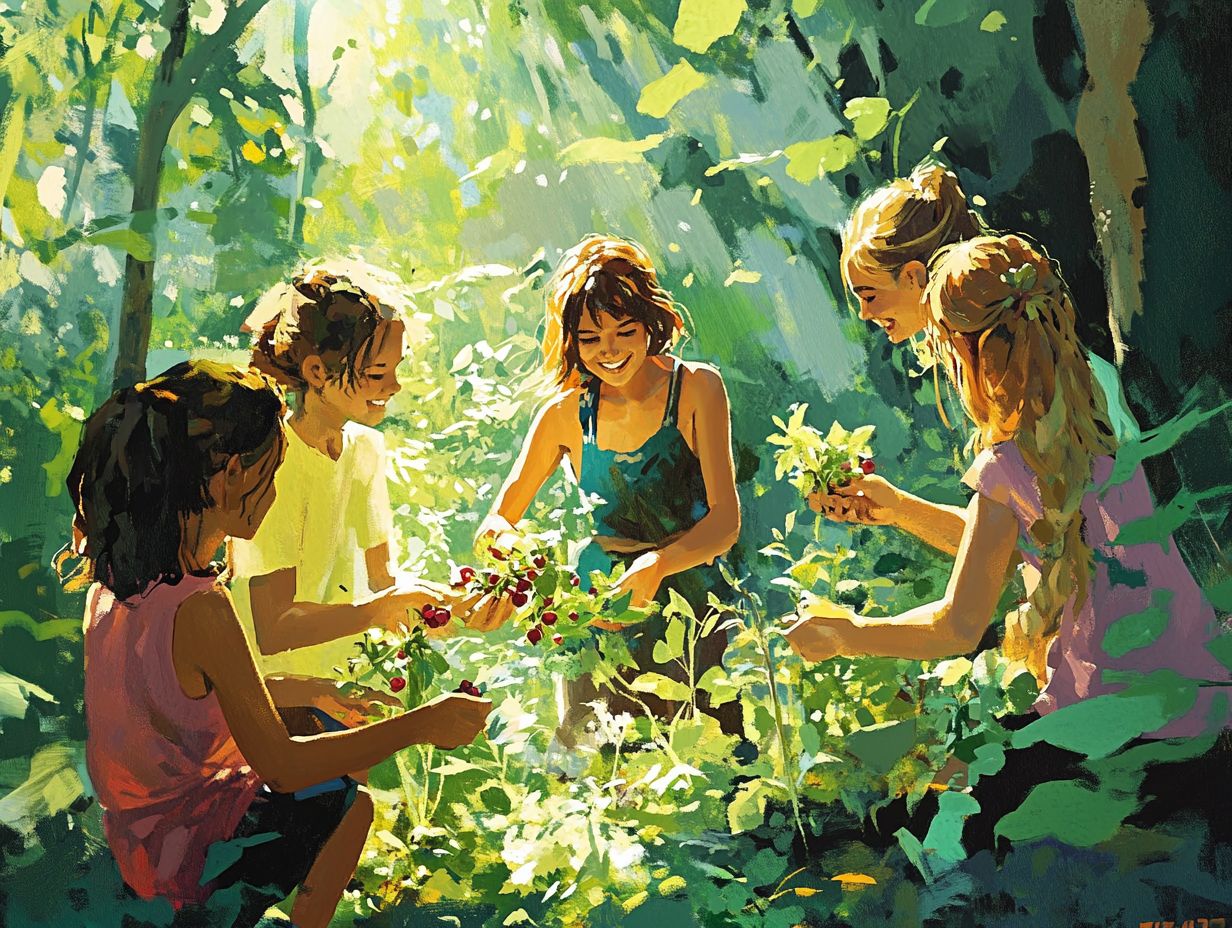Summer Foraging Adventures: Exploring Local Areas
Summer presents an exquisite opportunity for you to embrace the great outdoors and uncover nature’s hidden treasures through foraging. This age-old practice not only yields delicious and nutritious wild foods but also cultivates a profound connection with the environment.
As you explore the benefits of summer foraging, you’ll discover its nutritional benefits and positive effects on the ecosystem. Essential tips will guide you in getting started, pointing out the best local spots, and emphasizing the importance of responsible foraging practices.
Get ready to embark on an exciting foraging adventure! Consider joining foraging tours and wildlife tours to deepen your experience! Let s dive in!
Contents
- Key Takeaways for Your Foraging Journey!
- Benefits of Summer Foraging
- How to Get Started with Summer Foraging
- Exploring Local Areas for Foraging
- Foraging Etiquette and Sustainability
- Frequently Asked Questions
- What exactly is summer foraging?
- Why should I try summer foraging adventures with local ambassadors?
- What are some common plants and mushrooms to look for during summer foraging?
- Is it safe to eat wild plants and mushrooms?
- Can I forage in any local area?
- What are some tips for a successful summer foraging adventure?
Key Takeaways for Your Foraging Journey!

- Discover the world of foraging, a popular activity that involves gathering wild plants and mushrooms.
- Experience the numerous health and environmental benefits of foraging in the summer, such as adding nutrient-rich food to your diet and promoting sustainability.
- Get started with summer foraging by acquiring the necessary equipment and following safety tips. Then explore local areas to find the best spots for a successful and responsible foraging adventure.
What is Foraging? Why You Should Try It!
Foraging is the art of searching for and gathering wild food. It has gained popularity due to a growing interest in sustainable living.
People are eager to explore local ecosystems. They want to unearth edible treasures like morel mushrooms and elderberries. It s not just about the rich flavors of wild food; it s also about promoting a variety of plant and animal life and embracing gathering food without harming the environment.
Historically, foraging was an important skill for survival, intricately woven into the tapestry of indigenous cultures and communities across the globe. In today’s world, this revival of foraging mirrors a broader movement toward natural foods and a desire to reconnect with the land.
The modern foraging community is alive and thriving, with workshops, guided tours, and online forums where you can exchange tips and personal experiences with fellow enthusiasts.
As you discover popular finds like wild garlic, dandelions, and various mushrooms, you enrich your culinary adventures while highlighting the importance of preserving habitats. By learning to forage responsibly, you cultivate a deeper respect for nature, fostering both knowledge and stewardship of your local ecosystems.
Benefits of Summer Foraging
Summer foraging presents a wealth of advantages that cater to your nutritional needs while championing environmental sustainability. It’s no wonder this activity has captivated wild food enthusiasts and advocates of food sovereignty alike, especially when exploring the top local edibles to forage in your area.
By sourcing wild edible plants, you not only enrich your diet with seasonal flavors but also actively participate in community outreach, fostering sustainable practices within your local ecosystems.
Embracing this endeavor allows you to connect with nature and contribute positively to the environment around you.
Nutritional and Environmental Benefits
The nutritional benefits of foraging are impressive, granting you access to a diverse array of wild edible plants that provide essential vitamins and minerals. This not only enhances your overall health and well-being but also promotes variety of plant and animal life within our ecosystems.
Take morel mushrooms, for instance. They’re low in calories yet packed with vital vitamins D, B2, and B3, all crucial for your body’s functions. Similarly, blackberries are a delicious source of dietary fiber, vitamin C, and antioxidants, serving as a powerhouse for immune support and digestive health.
But the benefits extend beyond mere nutrition. Studies by ecologists reveal that foraging supports biodiversity by encouraging the growth of native plant species and sustaining local wildlife habitats.
By foraging, you inadvertently contribute to maintaining ecological balance and the interdependence of species, playing a pivotal role in conserving local ecosystems.
Experts highlight that engaging with wild food sources can also boost community awareness about local flora and advocate for sustainable harvesting practices. Embracing foraging enriches your diet while deepening your connection with the environment and community.
How to Get Started with Summer Foraging

Embarking on summer foraging requires you to grasp the essential equipment, enroll in foraging classes, and master plant identification techniques. This ensures your experience in the great outdoors is both safe and enjoyable.
You can significantly enhance your foraging journey by participating in hands-on workshops led by local experts like Dave Odd or Steve Brill. These knowledgeable ambassadors prioritize foraging safety and ethical practices. They ensure you not only learn but also appreciate the art of foraging responsibly.
Equipment and Safety Tips
Having the right equipment is essential for your foraging adventure. Understanding safety tips can ensure your experience is enjoyable and ethically responsible, especially when it comes to plant identification and foraging safety.
Essential tools like sturdy bags or baskets for your finds, sharp knives for harvesting, and comprehensive guides can significantly enhance your experience. A reliable field guide will be your best friend, helping you recognize edible varieties and steering you clear of toxic lookalikes, or plants that look similar but are unsafe to eat. Familiarity with local flora is invaluable; consider utilizing additional resources like apps or workshops to elevate your skills.
Prioritizing safety means you should set clear rules for foraging never consume any plant unless you re absolutely certain of its edibility. By practicing ethical foraging minimizing your environmental impact and respecting nature you’ll help ensure that these valuable resources remain available for generations to come.
Exploring Local Areas for Foraging
Exploring local areas for foraging opens up a treasure trove of wild food options just waiting to be discovered. Whether you’re wandering through urban foraging spots in Chicago, including locations highlighted by Eat the Neighborhood, or embarking on rural adventures in Iroquois County, get ready to connect with nature in an exciting and unique way!
Imagine savoring a summer filled with fresh, foraged ingredients that you ve gathered yourself there s nothing quite like it.
Best Places to Forage in the Summer
Some of the finest summer foraging spots await you in Kankakee County and various locations around the Chicago Metro area, where wild edible plants like elderberries and Common Milkweed flourish in their natural habitats.
In Kankakee County, you’ll find lush wetlands and wooded areas that create a rich ecosystem. This reveals nutritious wild greens such as dandelions and lamb s quarters for the discerning forager, as well as wild botanicals that can enhance your foraging experience.
Meanwhile, the Chicago Metro area boasts several parks, including Lincoln Park and Jackson Park, renowned for their plentiful foraging opportunities think delightful blackberries and aromatic garlic mustard.
Joining local foraging groups, like the Chicago Botanic Garden’s workshops or events hosted by Land of Odd, offers you invaluable guidance and fosters a sense of community. These groups frequently organize expeditions for newcomers eager to expand their skills and provide team-building opportunities.
Engaging with fellow foragers not only elevates your experience but also helps you cultivate a network of like-minded individuals who share a passion for sustainable gathering.
Foraging Etiquette and Sustainability

Foraging etiquette plays a crucial role in fostering sustainable practices and nurturing a harmonious relationship with nature. It involves embracing responsible foraging methods that prioritize community outreach and safeguard the delicate balance of our ecosystems.
By adhering to these principles, you contribute to the well-being of both the environment and your community.
Don t miss out on the summer’s freshest finds get out there and start foraging!
Ready to discover the wild? Grab your gear and head out today!
Responsible Foraging Practices
Responsible foraging practices are essential for maintaining sustainability and promoting ethical foraging. You ll need a keen understanding of plant identification and the ecosystems in which these plants flourish. This knowledge equips you to select safe and edible plants while minimizing your impact on local habitats.
Adopting sustainable harvesting techniques is essential for a rewarding foraging experience! This means only taking what you need so plants can regrow. Getting involved with your local community enhances knowledge sharing and fosters a collective responsibility toward preserving natural resources.
Participating in immersive workshops and local foraging groups can provide excellent platforms for education. Here, both novice and seasoned foragers can learn from one another, empowering everyone to engage in ethical practices. This contributes to the preservation of nature’s bounty, ensuring that everyone leaves with a richer understanding of wild food.
Frequently Asked Questions
What exactly is summer foraging?
Summer foraging is the practice of gathering wild edible plants and mushrooms during the summer season. It involves exploring local areas to find and harvest these nutritious and delicious foods. For tips on this practice, check out what to know about seasonal foraging in your area.
Why should I try summer foraging adventures with local ambassadors?

Summer foraging is not only a fun and unique outdoor activity, but it also allows you to connect with nature and learn more about the local flora. To get started, check out these summer foraging essentials. Plus, the food you gather is fresh, healthy, and free!
What are some common plants and mushrooms to look for during summer foraging?
Some common plants to look for include wild berries, ramps, dandelion greens, and wild garlic. Common mushrooms to look for are morels, a type of edible mushroom, chanterelles, known for their golden color, and oyster mushrooms.
Is it safe to eat wild plants and mushrooms?
While many wild plants and mushrooms are safe to eat, it is important to properly identify them before consuming. Do your research, use a field guide, or go foraging with an experienced guide to ensure you gather safe and edible plants.
Can I forage in any local area?
Some areas may have restrictions on foraging, so it is important to check with local authorities or landowners before gathering any plants or mushrooms. Always practice sustainable foraging techniques and only take what you need.
What are some tips for a successful summer foraging adventure?
Some tips for a successful summer foraging adventure include wearing appropriate clothing and footwear, bringing a field guide or an experienced guide, and practicing leave no trace principles. For those interested in seasonal foraging, check out the top local spots for autumn foraging in your area. Respect the environment and only take what you plan to use.




![Top Local Edibles to Forage in [Your Area]](https://forageadept.com/wp-content/uploads/2024/08/top-local-edibles-to-forage-in-your-area-1X-768x578.jpeg)
![Top 5 Foraging Locations in [Your Area] This Winter](https://forageadept.com/wp-content/uploads/2024/08/top-5-foraging-locations-in-your-area-this-winter-7a-768x578.jpeg)
